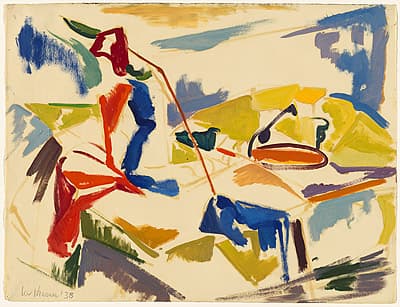
Lee
KRASNER
United States of America
1908
–
1984
Still life
1938
oil
on paper
signed and dated l.l. in pencil "Lee Krasner '38"
image
47.8 (h)
x 63.0 (w)
cm
sheet
47.8 (h)
x 63.0 (w)
cm
Purchased 1980
National Gallery of Australia, Canberra
NGA 1980.108
- the artist;
- with Pace Gallery, New York;
- from whom bought by the Australian National Gallery, February 1980
- Abstract Expressionism: the National Gallery of Australia celebrates the centenaries of Jackson Pollock and Morris Louis
- 14 Jul 2012 – 24 Feb 2013
- Ellen G. Landau, Lee Krasner: A catalogue raisonné, New York: Harry N. Abrams 1995, cat. 49, p. 39, p. 42, illus. b&w p. 43
Still life, is one of 18 near-identically formatted oil on paper studies produced by Krasner in 1938.[1] At the time, Krasner was a student enrolled at the Hans Hofmann School of Fine Arts, and these oil studies—if taken as a distinct developmental series—reveal her absorption and experimentation with the aesthetic theories of Analytical Cubism as espoused by Hofmann, an influential teacher and early exponent of Abstract Expressionism.
Hofmann set for his students a routine of life drawing in charcoal during morning sessions and still life studies in colour for the afternoon. Still life was produced during one such afternoon session, with Krasner testing an application of Hofmann’s ‘push/pull’ theory by deliberately contrasting warm and cool colours against one another in order to model space in the third dimension. Whilst various objects including a table lamp, glass, bottle and fruit, can be recognised in a number of the 18 compositions, Still life has been almost completely abstracted.
The scene in this drawing is punctuated with white areas of its paper, in a deliberate breaking apart of the objects and a reversal of the ‘empty’ ground as modelled ‘positive’ space. Krasner is also experimenting with the sculpting of space through colour, removing the outline of all forms to enable the often opposing coloured fragments (orange against blue, yellow against purple and red against green) to shift and move across the composition free of prescribed boundaries. The diagonal armature that drops from the upper left to centre, and the orange and green diagonals of the lower corners (that outline the barely recognisable tabletop), are among the very few guiding lines that remain, forming a skeletal framework around which the coloured patches are assembled.
The composition is signed and dated in pencil in the lower left hand corner, ‘Lee Krasner ‘38’. As noted by Ellen G. Landau in her catalogue raisonné of Krasner’s work, this is a retrospective attribution as the artist was identifying herself as ‘Lenore Krassner’ during her student period.[2] Krasner went through several early name adjustments that appear indicative of a personal grappling with her identity and self-verification.
Jaklyn Babington
[1] See, for example, Still life 1938, oil on paper, 43.8 x 63.5 cm, Collection; The Museum of Modern Art, New York; the majority of the other works are in the Pollock–Krasner Foundation; refer Ellen G. Landau, Lee Krasner: A catalogue raisonné, New York: Harry N. Abrams 1995, cats no. 38–56, pp. 39–44.
[2] Landau, p. 10.
The National Gallery of Australia holds a painting and six other works on paper by Krasner: two charcoal drawings from the late 1930s, an oil and gouache collage from 1953, and three lithographs.
